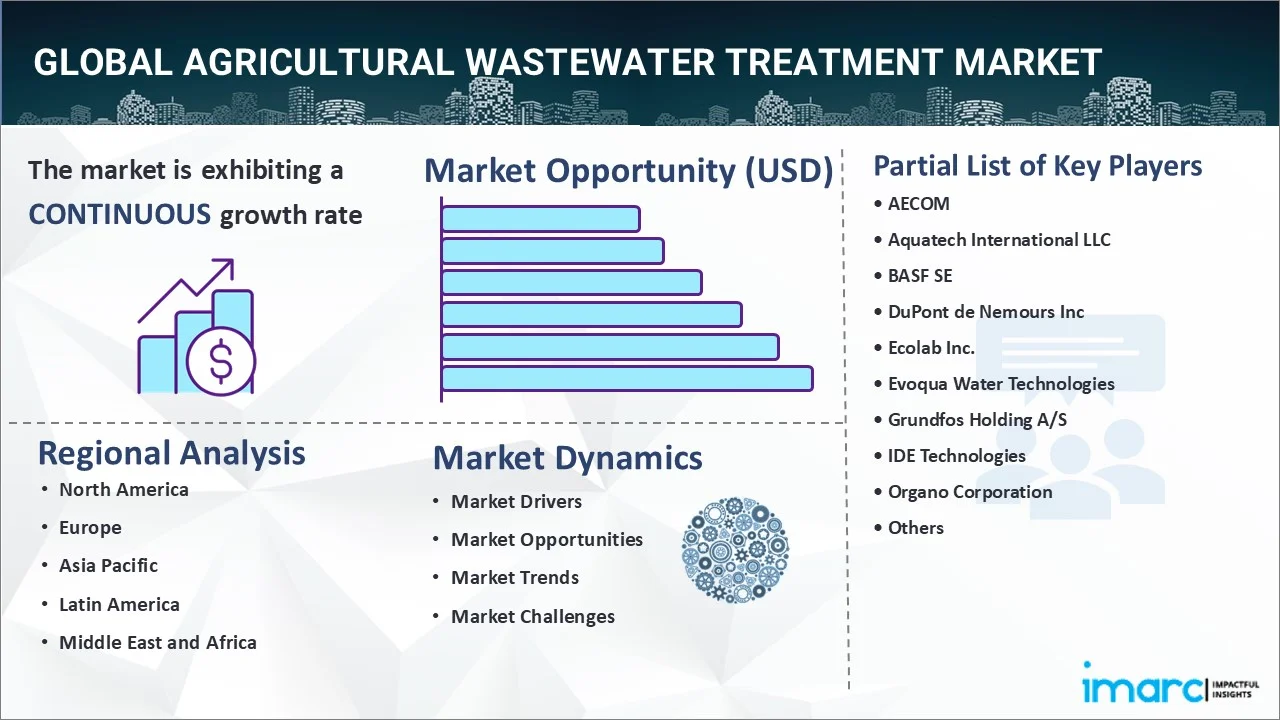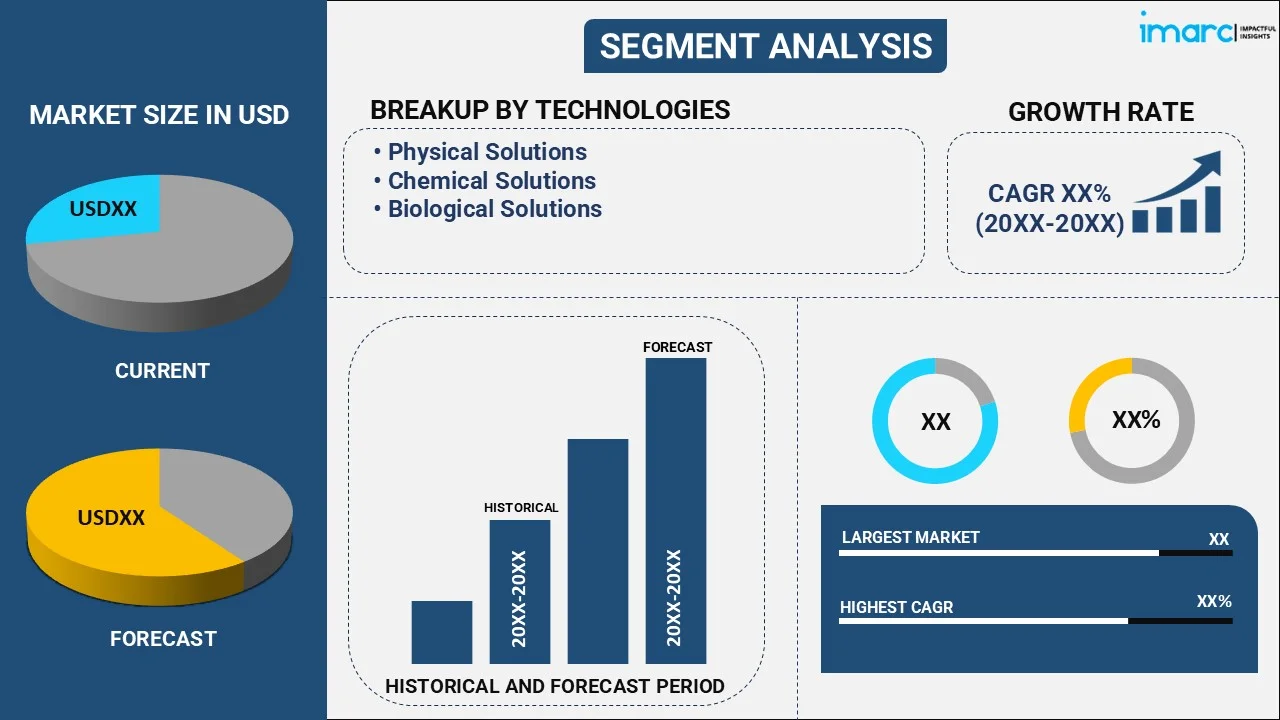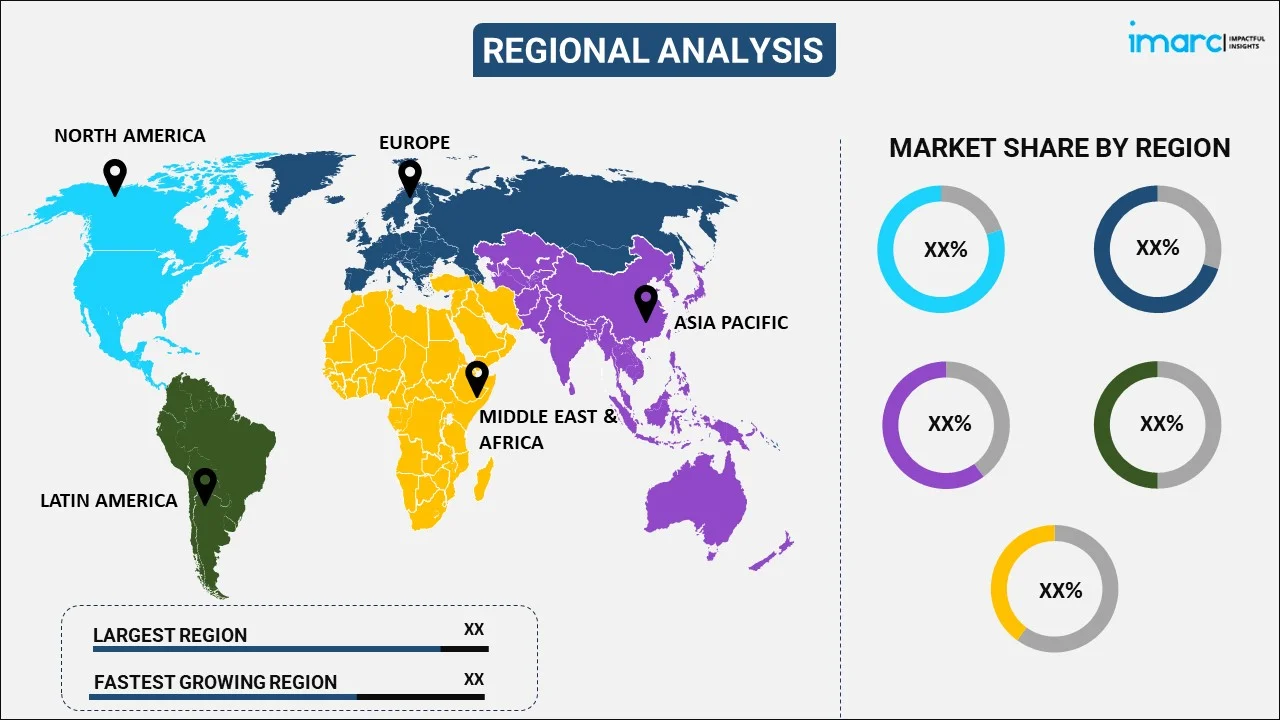
Agricultural Wastewater Treatment Market Report by Technology (Physical Solutions, Chemical Solutions, Biological Solutions), Pollutant Source (Point Source, Non-Point Source), Application (Non-Crop, Crop), and Region 2025-2033
Market Overview:
The global agricultural wastewater treatment market size reached USD 2.4 Billion in 2024. Looking forward, IMARC Group expects the market to reach USD 3.3 Billion by 2033, exhibiting a growth rate (CAGR) of 3.2% during 2025-2033. The increasing agriculture activities across the globe, the implementation of stringent regulations regarding wastewater discharge from agricultural activities, and the growing awareness about environmental sustainability among the masses represent some of the key factors driving the market.
|
Report Attribute
|
Key Statistics
|
|---|---|
|
Base Year
|
2024
|
|
Forecast Years
|
2025-2033
|
|
Historical Years
|
2019-2024
|
|
Market Size in 2024
|
USD 2.4 Billion |
|
Market Forecast in 2033
|
USD 3.3 Billion |
| Market Growth Rate (2025-2033) | 3.2% |
Agricultural wastewater treatment refers to the processes used to manage and treat water that has been contaminated by agricultural activities. The primary aim of agricultural wastewater treatment is to remove or reduce these contaminants to levels that are safe for either discharge into water bodies or reuse for irrigation or other purposes. It involves various stages of treatment, ranging from physical separation to biological and chemical processes, with the aim of returning the water to a state where it can be safely reused or discharged. This helps in preventing water pollution and conserving water resources. After treatment, the wastewater is reused for agricultural purposes, such as irrigation, or other applications depending on the level of treatment.

The growing concern over water scarcity worldwide has increased the need for water recycling and reuse in agriculture. Wastewater treatment technologies enable the recycling of water for irrigation and other purposes, driving demand. In addition, innovations and advancements in wastewater treatment technologies, such as membrane bioreactors and reverse osmosis, provide more efficient and cost-effective solutions. These advancements support market growth by offering practical solutions for the agricultural industry. Moreover, increasing population leads to a rise in food demand, resulting in intensified agricultural activities. This escalation necessitates proper wastewater management to prevent environmental degradation, further driving the market. Furthermore, the growing awareness about the environmental impact of untreated agricultural wastewater and the importance of sustainable farming practices contributes to market growth. Educational campaigns and initiatives by governments and NGOs promote the adoption of wastewater treatment systems.
Agricultural Wastewater Treatment Market Trends/Drivers:
Implementation of stringent regulations
Governments, environmental agencies, and international organizations are implementing stringent rules and guidelines concerning water pollution control and sustainable water management. These regulations mandate the treatment of wastewater generated from agricultural activities before it's discharged into water bodies to prevent contamination and preserve aquatic ecosystems. In many jurisdictions, failure to comply with these regulations results in penalties or sanctions, thereby incentivizing the agricultural sector to invest in wastewater treatment solutions. Besides legal compliance, these regulations resonate with the growing global emphasis on environmental stewardship and social responsibility. This trend encourages collaboration between governments, industries, research institutions, and communities to develop and adopt efficient, eco-friendly wastewater treatment technologies and practices.
Various technological advancements
Technological advancements in wastewater treatment are substantially contributing to the growth of the market. Research and development initiatives have led to the introduction of innovative technologies, such as membrane bioreactors, reverse osmosis, and anaerobic digestion, offering more effective, energy-efficient, and cost-optimized solutions. These technologies enable the removal of contaminants, pathogens, and nutrients from agricultural wastewater, making it suitable for recycling and reuse. This capability is particularly vital in regions facing water scarcity, where treated wastewater can be utilized for irrigation or other non-potable applications. Additionally, advancements in automation, monitoring, and control systems enhance the operational efficiency and reliability of treatment processes. By integrating these state-of-the-art technologies, the agricultural sector can comply with environmental regulations, reduce water consumption, minimize waste, and contribute to the circular economy.
Increasing water scarcity and need for recycling
Presently, with agriculture being one of the largest consumers of freshwater, the pressure on water resources is intensifying, especially in arid and semi-arid regions. This challenge necessitates the implementation of water recycling and reuse strategies within the agricultural sector. Agricultural wastewater treatment plays a critical role in this context by transforming wastewater into a reusable resource. Treated wastewater can be utilized for various purposes, including irrigation, livestock watering, and even aquaculture, depending on the treatment level. By adopting wastewater treatment solutions, farmers can optimize water usage, reduce dependence on freshwater sources, and mitigate the impact of drought and water shortages. This approach aligns with the global goals of sustainable water management, enhancing water security, and promoting responsible agricultural practices.
Agricultural Wastewater Treatment Industry Segmentation:
IMARC Group provides an analysis of the key trends in each segment of the global agricultural wastewater treatment market report, along with forecasts at the global, regional and country levels for 2025-2033. Our report has categorized the market based on technology, pollutant source and application.
Breakup by Technology:

- Physical Solutions
- Chemical Solutions
- Biological Solutions
Chemical solutions represent the most used technology
The report has provided a detailed breakup and analysis of the market based on technology. This includes physical solutions, chemical solutions, and biological solutions. According to the report, chemical solutions represented the largest segment.
Chemical solutions, including coagulants, flocculants, and disinfectants, are highly effective in removing contaminants like suspended solids, pathogens, heavy metals, and nutrients from wastewater. The treatment process involves the alteration of the physical and chemical properties of pollutants, making them easier to separate and remove from the water. This ability to address a wide range of contaminants makes chemical treatment a popular choice in agriculture. Moreover, compared to some advanced treatment technologies, chemical solutions are often more cost-effective, especially in initial capital investment. The technology and equipment required for chemical treatment are relatively simple and less expensive, making them accessible to a broader range of agricultural operations.
Breakup by Pollutant Source:
- Point Source
- Non-Point Source
Non-point source is the most common pollutant source
A detailed breakup and analysis of the market based on the pollutant source has also been provided in the report. This point source and non-point source. According to the report, non-point sources represent the leading segment.
In agriculture, non-point source pollutants include fertilizers, pesticides, herbicides, and animal waste that are applied to fields and can run off into nearby water bodies. This runoff occurs over a broad area, making it difficult to pinpoint a single origin. Non-point source pollution is highly influenced by weather conditions, such as rain and snowmelt. Rainfall can wash pollutants from agricultural land into streams, rivers, and lakes. The sporadic and unpredictable nature of weather events adds to the complexity of controlling and treating this type of pollution. Moreover, controlling non-point source pollution requires a comprehensive understanding of hydrological, geological, and biological factors. Solutions may involve changes in land management, farming practices, and the use of new technologies, all of which can be costly and time-consuming to implement.
Breakup by Application:
- Non-crop
- Crop
Non-crop applications hold the largest market share
The report has provided a detailed breakup and analysis of the market based on application. This includes non-crop and crop. According to the report, non-crop applications hold the largest market share.
Non-crop applications in agricultural wastewater treatment encompass a wide variety of uses such as aquaculture, livestock watering, soil irrigation for non-food plants, cooling, cleaning, and recreational water bodies. The diversity of these applications extends the market reach, catering to different sectors within and beyond agriculture. Moreover, many countries enforce regulations that require the treatment of wastewater before it can be used for non-crop purposes. These regulations aim to protect both the environment and public health. Complying with these regulations necessitates the adoption of wastewater treatment solutions, driving the market.
Breakup by Region:

- North America
- United States
- Canada
- Europe
- Germany
- France
- United Kingdom
- Italy
- Spain
- Russia
- Others
- Asia Pacific
- China
- Japan
- India
- South Korea
- Australia
- Indonesia
- Others
- Latin America
- Brazil
- Mexico
- Others
- Middle East and Africa
Asia Pacific exhibits a clear dominance in the market
The report has also provided a comprehensive analysis of all the major regional markets, which include North America (United States, Canada); Asia-Pacific (China, Japan, India, South Korea, Australia, Indonesia, Others); Europe (Germany, France, United Kingdom, Italy, Spain, Russia, Others); Latin America (Brazil, Mexico, Others); and the Middle East and Africa. According to the report, Asia Pacific accounted for the largest market share.
Asia Pacific is home to some of the largest agricultural economies in the world, including countries like China, India, and Indonesia. The extensive agricultural activities generate significant volumes of wastewater, requiring proper treatment and management. Moreover, many countries in the region have implemented stringent regulations concerning wastewater treatment and environmental protection. Government initiatives to support the adoption of wastewater treatment technologies provide an essential framework for market growth. Besides, Asia Pacific has seen substantial investments in research, innovation, and technology adoption in the field of wastewater treatment. Countries like Japan and South Korea lead in technological innovation, contributing to the region's market dominance.
Competitive Landscape:
The competitive landscape of the market is characterized by the presence of various key players, ranging from established multinational corporations to emerging local companies. Nowadays, key players are investing in R&D to develop innovative technologies and solutions that improve efficiency, reduce costs, and offer unique features. They are also collaborating with other industry players, universities, research institutions, or government bodies to provide access to specialized expertise, new technologies, and unique market insights. Moreover, they are implementing advanced technologies for remote monitoring and control or using AI to optimize treatment processes. Some players are also creating more energy-efficient treatment systems or developing technologies that can treat specific contaminants unique to agricultural wastewater.
The report has provided a comprehensive analysis of the competitive landscape in the market. Detailed profiles of all major companies have also been provided. Some of the key players in the market include:
- AECOM
- Aquatech International LLC
- BASF SE
- DuPont de Nemours Inc
- Ecolab Inc.
- Evoqua Water Technologies
- Grundfos Holding A/S
- IDE Technologies
- Organo Corporation
- Veolia Environnement S.A.
Recent Developments:
- Aquatech International LLC has launched a specialized ZLD system for the agricultural sector, aiming to eliminate wastewater discharge and recover valuable resources from the waste.
- AECOM, a global engineering, consulting, and construction services company, completed the design for its new North Shore wastewater treatment plant aimed at addressing wastewater management and environmental sustainability.
- Veolia Environnement S.A. has developed advanced technologies, such as membrane bioreactors and reverse osmosis systems, to treat agricultural wastewater and produce high-quality water for irrigation purposes.
Agricultural Wastewater Treatment Market Report Scope:
| Report Features | Details |
|---|---|
| Base Year of the Analysis | 2024 |
| Historical Period | 2019-2024 |
| Forecast Period | 2025-2033 |
| Units | Billion USD |
| Scope of the Report | Exploration of Historical and Forecast Trends, Industry Catalysts and Challenges, Segment-Wise Historical and Predictive Market Assessment:
|
| Technologies Covered | Physical Solutions, Chemical Solutions, Biological Solutions |
| Pollutant Sources Covered | Point Source, Non-Point Source |
| Applications Covered | Non-Crop, Crop |
| Regions Covered | Asia Pacific, Europe, North America, Latin America, Middle East and Africa |
| Countries Covered | United States, Canada, Germany, France, United Kingdom, Italy, Spain, Russia, China, Japan, India, South Korea, Australia, Indonesia, Brazil, Mexico |
| Companies Covered | AECOM, Aquatech International LLC, BASF SE, DuPont de Nemours Inc, Ecolab Inc., Evoqua Water Technologies, Grundfos Holding A/S, IDE Technologies, Organo Corporation, Veolia Environnement SA, etc. |
| Customization Scope | 10% Free Customization |
| Post-Sale Analyst Support | 10-12 Weeks |
| Delivery Format | PDF and Excel through Email (We can also provide the editable version of the report in PPT/Word format on special request) |
Key Benefits for Stakeholders:
- IMARC’s report offers a comprehensive quantitative analysis of various market segments, historical and current market trends, market forecasts, and dynamics of the agricultural wastewater treatment market from 2019-2033.
- The research study provides the latest information on the market drivers, challenges, and opportunities in the global agricultural wastewater treatment market.
- The study maps the leading, as well as the fastest-growing, regional markets. It further enables stakeholders to identify the key country-level markets within each region.
- Porter's five forces analysis assist stakeholders in assessing the impact of new entrants, competitive rivalry, supplier power, buyer power, and the threat of substitution. It helps stakeholders to analyze the level of competition within the agricultural wastewater treatment industry and its attractiveness.
- Competitive landscape allows stakeholders to understand their competitive environment and provides an insight into the current positions of key players in the market.
Key Questions Answered in This Report
The global agricultural wastewater treatment market was valued at USD 2.4 Billion in 2024.
We expect the global agricultural wastewater treatment market to exhibit a CAGR of 3.2% during 2025-2033.
The rising need for farm mechanization, along with the increasing adoption of agricultural wastewater treatment, as it eliminates toxic or carcinogenic organic compounds and makes water suitable for reuse, is primarily driving the global agricultural wastewater treatment market.
The sudden outbreak of the COVID-19 pandemic had led to the implementation of stringent lockdown regulations across several nations, resulting in the temporary halt in various agricultural activities, thereby negatively impacting the global market for agricultural wastewater treatment.
Based on the technology, the global agricultural wastewater treatment market can be categorized into physical solutions, chemical solutions, and biological solutions. Among these, chemical solutions account for the majority of the global market share.
Based on the pollutant source, the global agricultural wastewater treatment market has been segregated into point source and non-point source, where non-point source currently exhibits a clear dominance in the market.
Based on the application, the global agricultural wastewater treatment market can be bifurcated into non-crop and crop. Currently, non-crop holds the largest market share.
On a regional level, the market has been classified into North America, Asia-Pacific, Europe, Latin America, and Middle East and Africa, where Asia-Pacific currently dominates the global market.
Some of the major players in the global agricultural wastewater treatment market include AECOM, Aquatech International LLC, BASF SE, DuPont de Nemours Inc, Ecolab Inc., Evoqua Water Technologies, Grundfos Holding A/S, IDE Technologies, Organo Corporation, and Veolia Environnement SA.
Need more help?
- Speak to our experienced analysts for insights on the current market scenarios.
- Include additional segments and countries to customize the report as per your requirement.
- Gain an unparalleled competitive advantage in your domain by understanding how to utilize the report and positively impacting your operations and revenue.
- For further assistance, please connect with our analysts.
 Request Customization
Request Customization
 Speak to an Analyst
Speak to an Analyst
 Request Brochure
Request Brochure
 Inquire Before Buying
Inquire Before Buying




.webp)




.webp)












